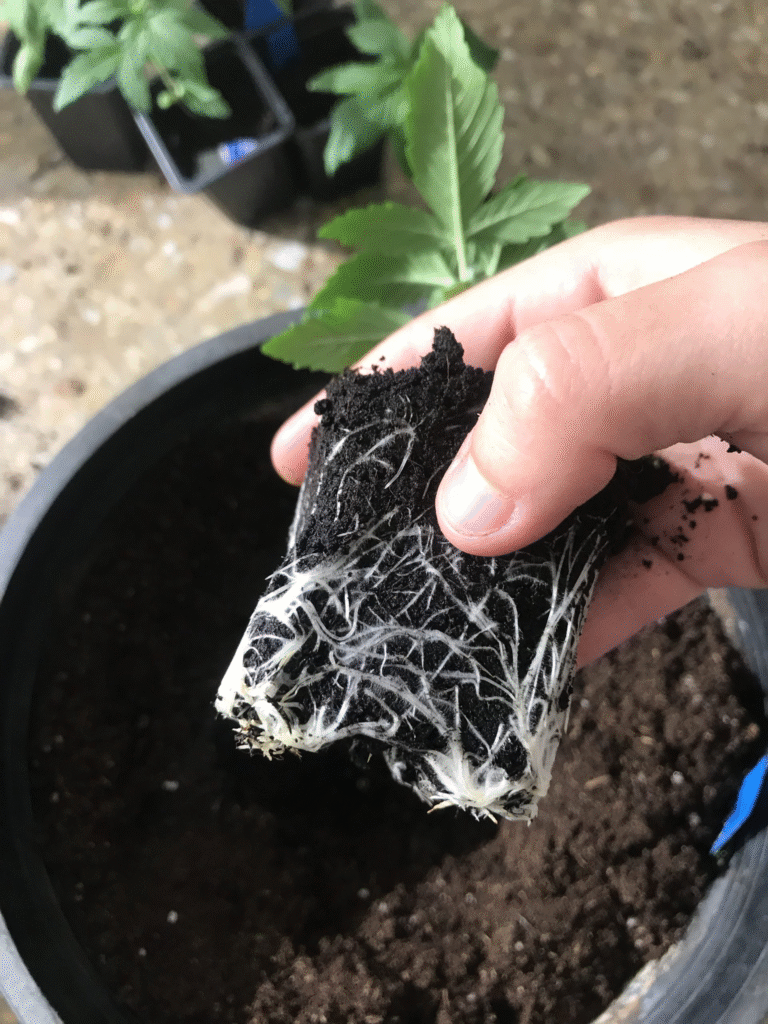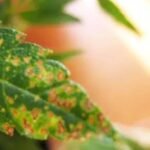The roots of cannabis plants are vitally important for the development of their plant parts as they are primary means of nutrient absorption.
A cannabis plant with few or small roots will not grow into a large and robust plant. However, a plant with a good root system can grow into a large, high-yielding plant.

What does transplanting involve?
Transplanting involves relocating a plant to a new growing medium or container with more volume to strengthen the development of the root system.
Roots need darkness, a little moisture, and oxygen. They shouldn’t be exposed to direct light, because it will burn them; they neither can be exposed to continuous air, as this will dehydrate them. During the transplanting process, these factors are crucial to avoid stress in the plant; transplants always cause some stress, and if they are not done properly, it will be worse.
A good transplanting medium has a lot to do with root development; a good transplanting medium would be an aerated, pathogen-free substrate. The different concentrations of fertilizer (NPK) depend on the substrate. If you grow feminized or regular photoperiod plants, choose a substrate with plenty of fertilizer, and if you grow autoflowering plants, choose a «lighter» substrate because autoflowering plants sometimes don’t adapt to high-fertilization substrates. Autoflowering plants are plants that need to be fertilized sparingly.
The shape of the roots partly determines how cannabis plants will grow; if the root system is deep and narrow, the plant will be taller and lankier; and if it is wide and shallower, the plant will grow wider than it is tall, so it is important to choose the right pots to use during cultivation.
When to transplant marijuana plants?
Photoperiod-dependent marijuana plants
They will be in the growth stage with an 18-hour light and 6-hour dark cycle. In indoor, you can start the flowering stage by switching to 12 hours of light and 12 hours of darkness once the plant has reached a good size.
- It is highly recommended to plant the germinated seed in a small pot of no more than one liter, as marijuana needs short cycles of humidity to grow quickly and proportionately.
- Transplant when the roots have colonized the substrate in which they are located. The plant will indicate this when it stops growing. Symptoms for doing so include general yellowing of the plant, nutrient blockages, and deficiencies.
Indoors transplant 1 to 2 times and Outdoors needs 2 to 4 times as the plant grows for longer because you cannot control the light cycle.
Autoflowering marijuana plants
Auto plants have a short growth period and begin flowering regardless of the hours of light they receive, as they don’t respond to photoperiods. Given their limited growth, germinated seeds can be planted directly into the final pot if grown outdoors. If grown indoors, you can start them in a pot no larger than one liter, and transplant them after about 20 days. I’m telling you this because I’ve tried it myself, and it turned out quite well.

- Use a root stimulant to promote root development and reduce stress during this period.
- Use mycorrhizae and benefical fungi to strengthen the development and protect the root system. Use only in organic crops because mineral products can negatively affect them.
Pre-Transplant preparation
- Don’t water for a day or two before transplanting. If the potting soil is a little dry, it will be more compact and the roots won’t come loose when you remove it.
- Make a mold of the potting soil in the new pot to make it easier to place the plant in.
Removing the Root bread
- Turn the pot with the plant upside down and press the bottom of the pot with your other hand to separate it from the potting soil, then remove it. If it’s difficult, gently tap the bottom of the pot to help it come out and never pull on the stem.
Watering after transplanting
- Use irrigation water along with a root stimulant.
- pH should be between 6.0 and 6.5.
- Water slowly until some water drains through the pot’s drainage.
- Let the plants rest from the stress they’ve experienced during the process. You should raise the lamps slightly, avoid directing fans to the plants amd wait for the substrate to dry slightly before watering again.
- If transplanting to a coconut fiber substrate, as it is an inert soil medium, you should add growth fertilizer to the irrigation water.
Pot Sizes
Indoor growing
- Small pot (max. 1 L): To plant germinated seeds and allowing approximately 7-10 days of growth untill the plant outgrows the pot.
- Growing pot (4 to 6 L): Used up to 1 week before the photoperiod change.
- Permanent pot (7 to 15 L, even larger if you plant to plant a few plants).
Outdoor Growing
- Small pot (max. 1 L): To plant germinated seeds.
- Growing pot: You have to transplant more than once before using the permanent pot.
- Permanent pot (max. 50 L): The larger the pot, the larger the final plant will be.
Vegetable Growing
- Small pot (max. 1 L): To plant germinated seeds or newly rooted cuttings; leave the plant in this pot for 15-20 days before transplanting again.
- To the final transplant to the garden, you should use a substrate rich in fertilizer, mycorrhizae and other beneficial fungi for the roots.







